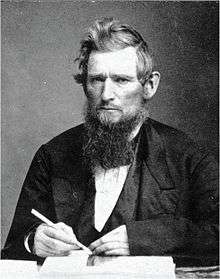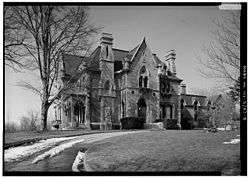Ezra Cornell
| Ezra Cornell | |
|---|---|
 | |
| 1st Chairman of Cornell Board of Trustees | |
|
In office 1866–1874 | |
| Succeeded by | Henry W. Sage |
| Member of the New York Senate from the 24th district | |
|
In office January 1, 1864 – December 31, 1867 | |
| Preceded by | Lyman Truman |
| Succeeded by | Orlow W. Chapman |
| Member of the New York State Assembly from the Tompkins County district | |
|
In office January 1, 1862 – December 31, 1863 | |
| Preceded by | Jeremiah W. Dwight |
| Succeeded by | Henry B. Lord |
| Personal details | |
| Born |
January 11, 1807 Westchester Landing, The Bronx, New York, U.S. |
| Died |
December 9, 1874 (aged 67) Ithaca, New York, U.S. |
| Signature |
|
Ezra Cornell (January 11, 1807 – December 9, 1874) was an American businessman, politician, philanthropist and educational administrator. He was the founder of Western Union and a co-founder of Cornell University. He also served as President of the New York Agriculture Society and as a New York state Senator.
Birth and early life
He was born in Westchester Landing, in what would become the Bronx, New York, the son of Eunice (Barnard), and a potter, Elijah Cornell, and was raised near DeRuyter, New York.[1] He was a cousin of Paul Cornell, the founder of Chicago's Hyde Park neighborhood. Cornell was also a distant relative of William Cornell, who was an early settler of Scarborough, Ontario whose name was used for the planned community of Cornell, Ontario. Having traveled extensively as a carpenter in New York State, Ezra, upon first setting eyes on Cayuga Lake and Ithaca, decided Ithaca would be his future home.
Ezra Cornell's earliest American patrilineal ancestor, Thomas Cornell (1595–1673), was probably Puritan at first then a follower of Roger Williams and Anne Hutchinson drifting into Quakerism which seems to have been the religion of Thomas Cornell's descendants.[2][3] [4] Portsmouth, RI is noteworthy in American history for the 1638 Portsmouth Compact declaring for a separation of church and state rivaling the Flushing Remonstrance of 1657 declaring for religious tolerance in New Amsterdam, Quakers in particular. Ezekiel Cornell, a Revolutionary War general, represented Rhode Island in the U.S. Continental Congress from 1780 to 1782.[5]
Marriage and early career
After settling in at Ithaca, Cornell quickly went to work proving himself as a carpenter. Colonel Beebe took notice of the industrious young man and made him the manager of his mill at Fall Creek.
Ezra Cornell was a birthright Quaker, but was later disowned by the Society of Friends for marrying outside of the faith to a "world's woman," a Methodist by the name of Mary Ann Wood. Ezra and Mary Ann were married March 19, 1831, in Dryden, New York.
On February 24, 1832, Ezra Cornell wrote the following response to his expulsion from The Society of Friends due to his marriage to Mary Ann Wood:
- I have always considered that choosing a companion for life was a very important affair and that my happiness or misery in this life depended on the choice…
The young and growing family needed more income than could be earned as manager of Beebe's Mills. So, having purchased rights in a patent for a new type of plow, Ezra began what would be decades of traveling away from Ithaca. His territories for sales of the plow were the states of Maine and Georgia. His plan was to sell in Maine in the summer and the milder Georgia in the winter. With limited means, what transported Ezra between the two states were his own two feet.
Telegraph
Happening into the offices of the Maine Farmer in 1842, Cornell saw an acquaintance of his, one F.O.J. Smith, bent over some plans for a "scraper" as Smith called it. For services rendered, Smith had been granted a one-quarter share of the telegraph patent held by Samuel F.B. Morse, and was attempting to devise a way of burying the telegraph lines in the ground in lead pipe.[6] Ezra's knowledge of plows was put to the test and Ezra devised a special kind of plow that would dig a 2½ foot ditch, lay the pipe and telegraph wire in the ditch and cover it back up as it went. Later it was found that condensation in the pipes and poor insulation of the wires impeded the electrical current on the wires and so hanging the wire from telegraph poles became the accepted method.
Cornell made his fortune in the telegraph business as an associate of Samuel Morse, having gained his trust by constructing and stringing the telegraph poles between Washington, D.C. and Baltimore, Maryland, as the first ever telegraph line of substance in the U.S. To address the problem of telegraph lines shorting out to the ground, Cornell invented the idea of using glass insulators at the point where telegraph lines are connected to supporting poles. After joining with Morse, Cornell supervised the erection of many telegraph lines, including a portion of the New York, Albany & Buffalo line in 1846 and the Erie and Michigan Telegraph Company connecting Buffalo to Milwaukee with partners John James Speed and Francis Ormand Jonathan Smith. Cornell, Speed and Smith also built the New York and Erie line competing with and paralleling to the south the New York, Albany and Buffalo line in which Morse had a major share.[7] The line was completed in 1849 and Cornell was made president of the company.
Cornell's sister Phoebe married Martin B. Wood and moved to Albion, Michigan, in 1848. Cornell gave Wood a job constructing new lines and made Phoebe his telegraph operator, the first woman operator in the United States.[8]
Cornell earned a substantial fortune when the Erie and Michigan was consolidated with Hiram Sibley and his New York and Mississippi Company to form the Western Union company.[9] Cornell received two million in Western Union stock.[10]
Cornell was a Republican member of the New York State Assembly (Tompkins Co.) in 1862 and 1863; and of the New York State Senate from 1864 to 1867, sitting in the 87th, 88th, 89th and 90th New York State Legislatures.
Cornell University
Cornell retired from Western Union and turned his attention to philanthropy. He endowed the Cornell Library, a public library for the citizens of Ithaca. A lifelong enthusiast of science and agriculture, he saw great opportunity in the 1862 Morrill Land-Grant Colleges Act to found a university that would teach practical subjects on an equal basis with the classics favored by more traditional institutions. Andrew Dickson White helped secure the new institution's status as New York's land grant university, and Cornell University was granted a charter through their efforts in 1865.
Lands granted by the Morrill Act to universities in states without substantial federal land could be claimed in those states which had a large surplus of unclaimed land. Cornell University's endowment was a stand out success based on Ezra Cornell's judicious investment in federal land, especially timber land in Wisconsin. Unlike most land grant universities, who sold their land immediately, under Ezra's leadership Cornell managed and maintained its land for an extended period, only selling it at the most opportune time. The university was able to reap an unprecedented $5 million endowment as a result.[11]

Later life
Ezra Cornell entered the railroad business, but fared poorly due to the Panic of 1873. He began construction of a palatial Ithaca mansion, Llenroc (Cornell spelled in reverse) to replace his farmhouse, Forest Home, but died before it was completed. Llenroc was maintained by Cornell's heirs for several decades until being sold to the local chapter of the Delta Phi fraternity, which occupies it to this day; Forest Home was sold to the Delta Tau Delta chapter and later demolished. Cornell is interred in Sage Chapel on Cornell's campus, along with Daniel Willard Fiske and Jennie McGraw. Cornell was originally laid to rest in Lake View Cemetery, Ithaca N.Y., then moved to Sage Chapel.
A prolific letter writer, Ezra corresponded with a great many people and would write dozens of letters each week. This was due partly to his wide traveling, and also to the many business associates he maintained during his years as an entrepreneur and later as a politician and university founder. Cornell University has made the approximately 30,000 letters in the Cornell Correspondence available online.
His eldest son, Alonzo B. Cornell, was later governor of New York. Since its founding, the University's charter specified that the eldest lineal descendent of Cornell is granted a life seat on Cornell University's Board of Trustees,[12] currently Charles Ezra Cornell. (Charles Ezra Cornell took the post on November 17, 1969,[13]
In 1990, G. David Low, graduate of Cornell University and Space Shuttle astronaut, took with him into outer space a pair of tan silk socks worn by Ezra Cornell on his wedding day in 1831.[14]
See also
- Henry Wells
- Mary Morrill Foulger - Ezra's 4th great-grandmother and Benjamin Franklin's grandmother
- Peter Foulger - Ezra's 4th great-grandfather and Benjamin Franklin's grandfather
- Cornell, Ontario - a planned community named after Cornell's distant relative William Cornell
- Flushing Remonstrance
| Wikimedia Commons has media related to Ezra Cornell. |
Sources
- New York Times Op-ed "A Colony With a Conscience" December 27, 2007
References
- ↑ Retrieved 2007-09-14. Biographical Website
- ↑ Written by John Cornell at the Cornell Homestead in So. Portsmouth, Rhode Island and dated August 7, 1901. http://ebooks.library.cornell.edu/cgi/t/text/text-idx?c=ezra;cc=ezra;view=toc;subview=short;idno=ezra000
- ↑ http://www.mindspring.com/~tvcornel/cemetery.html
- ↑ http://digital.library.cornell.edu/cgi/t/text/text-idx?c=ezra;cc=ezra;view=toc;subview=short;idno=ezra000
- ↑ http://docsouth.unc.edu/csr/index.html/document/csr14-0462
- ↑ James D. Reid, The Telegraph in America, New York: Arno Press, 1974
- ↑ Robert L. Thompson, Wiring A Continent, Princeton University Press, 1947, p.176
- ↑ Frank Passic, "Ezra Cornell Had Close Albion Ties," Albion Recorder, Febr. 22, 1999, p.4
- ↑ Robert L. Thompson, Wiring A Continent,p. 284.
- ↑ James D. Reid, The Telegraph in America, Arno Press, 1947, p. 470.
- ↑ Gates, Paul Wallace (2011). The Wisconsin Pine Lands of Cornell University. Ithaca and London: Fall Creek Books. ISBN 978-0-8014-7763-8. Retrieved July 5, 2015.
- ↑ New York State Education Law § 5703(b).
- ↑ + Ezra+Cornell+Trustee-all "Charles Ezra Cornell 21 Becomes First Student on Trustee Board" Check
|url=value (help). Cornell Daily Sun. 76 (49). November 17, 1969. p. 9. Retrieved 2010-12-03. - ↑ Kuznik, Frank (December 1994). "Personal Effects". Air&Space Magazine.
Further reading
- Dorf, Philip (1952). The Builder, A Biography of Ezra Cornell. New York: The Macmillan Co.
External links
| Wikisource has the text of a 1900 Appletons' Cyclopædia of American Biography article about Ezra Cornell. |
- Ezra Cornell, Andrew Dickson White and the Establishment of Cornell University
- "I Would Found an Institution": The Ezra Cornell Bicentennial
- Guide to the Ezra Cornell Papers, 1746–1888. Division of Rare and Manuscript Collections, Cornell University Library.
- Alonzo Barton Cornell. “True and Firm”: Biography of Ezra Cornell, Founder of the Cornell University. New York: A. S. Barnes & Co., 1884.
- John Cornell. Genealogy of the Cornell Family. Being an Account of the Descendants of Thomas Cornell of Portsmouth, R. I. New York: Press of T. A. Wright, 1902.
- The Ezra Files. Cornell University Chronicle Online.
- The Story of Telecommunications, George P. Oslin, 1992; ch. 5.
| New York Assembly | ||
|---|---|---|
| Preceded by Jeremiah W. Dwight |
New York State Assembly Tompkins County 1862–1863 |
Succeeded by Henry B. Lord |
| New York State Senate | ||
| Preceded by Lyman Truman |
New York State Senate 24th District 1864–1867 |
Succeeded by Orlow W. Chapman |
| Academic offices | ||
| Preceded by None |
Chairman of Cornell Board of Trustees 1866–1874 |
Succeeded by Henry W. Sage |